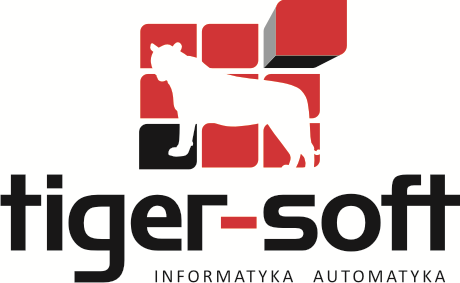
Warsaw 20.11.2020
OPC_SCHRACK VER. 4.7
MANUAL

Zwolenska 22/27
04-761 Warszawa
tel./fax: (+48 22) 615-89-84
e-mail: tiger-soft@tiger-soft.com.pl
Table of contents
1) Introduction
2) Installing the I/O driver
3) Software registration
4) Configuring the OPC_SCHRACK
5) Configuring an OPC client
6) Starting and stopping the OPC_SCHRACK
The OPC_SCHRACK ver. 4.7 is a communication driver which allows to connect BMS system
with several fire protection systems from Schrack Seconet via RS232 or ETHERNET channels. The Integral Standard Protocol (ISP) is used by the driver.
The computer with BMS system uses a serial port (RS232) or ETHERNET network card. Schrack central can use one of the following modules:
B3-USI4,B3-LPI,B4-USI for a RS232 or network cards like B5-NET2-FXM for an ETHERNET. The driver can be connected to BMZ Integral IP, Integral C or Integral system.
It includes the following features:
Run OPC_SCHRACK_INSTALL.EXE.Installation software will put OPC_SCHRACK files into the C:\Program Files\TIGER_SOFT\OPC_SCHRACK_4_7 directory or another directory chosen by the user. Shortcuts to the manual and registration software exist in the group OPC_SCHRACK ver. 4.7 (access from the Start menu). The driver is installed as a service.
OPC_SCHRACK should be registered after installation using TIGER-SOFT internet service. SOFTWARE REGISTRATION from OPC_SCHRACK group should be started first. This program generates file gen_lic.lic and saves it in the main driver directory. Then you have to connect to http://www.tiger-soft.com.pl/Registration/registration.html, fill the form and receive the registration code. This code should be put to the editable field in the SOFTWARE REGISTRATION. Press OK to finish registration process.
4) Configuring the OPC_SCHRACK
The file - Configuration.oes is used for the driver configuration. It exists in the same directory like the OPC_SCHRACK.exe.
An example of the file is presented below.
# OPC_SCHRACK - configuration program
# CHANNEL - channel number
# ACTIVE - channel activation. Possible values YES,NO
# RS232_ETH - RS232 (COM) or ETHERNET connection. Possible values 0-RS232 1-ETH
# COM parameters
# NR_COM from the range 1-99
# BAUD_RATE [bits/s]. Possible values: 9600,14.70,19200,384.7,57600,115200
# PARITY N-None,E-Even,O-Odd
# ETH parameters
# CL_IP is a local driver ip address
# SCHRACK_IP is a Schrack-Seconet central ip address
# USER is an user name defined in a central
# PASSWORD is an user password defined in a central
# ETH parameters
# CL_IP is a local driver ip address
# CL_PORT is a local driver port address
# SCHRACK_IP is a Schrack-Seconet central ip address
# USER is an user name defined in a central
# PASSWORD is an user password defined in a central
# TIMEOUT [s]. Possible values from the range 1-9999 [s]
# ISP parameters
# CENTRAL - Address of the central unit has the following structure Subnet.Node.Client, where Subnet=0-63; Node=0-63; Client=0-7;
# CLIENT - Address of the client has the following structure Subnet.Node.Client, where Subnet=0-62; Node=0-61; Client=0-5;
# TOKENTIME [ms]. Possible values from the range 30-250 [ms]
# SS=1 - Additional status will be sent in the older byte of the word.0 - will be always 0
# AS=1 - Driver allows to send commands to the fire alarm central unit (XccCTttAaa[sa]). 0 - Sending control commands is not allowed.
# AG=1 - Driver will set group status to alarm when an element from this group has alarm status.
# OPC points
# The list of points, configured in the OPC client in the following format:
# XccTtt[st]Aaa[sa], where cc-channel number, tt-type(0-16,255,4095), aa-address of the element(1-65535), sa-sub address of the element(0-255)
# or XccCTttAaa[sa] for control points, sent by the OPC client
#******************** 1 ********************
CHANNEL=1
ACTIVE=YES
RS232_ETH=1
#RS_232
NR_COM=1
BAUD_RATE=19200
PARITY=E
#ETH
CL_IP=192.168.1.53
CL_PORT=11113
SCHRACK_IP=192.168.1.71
USER=Tiger-Soft
PASSWORD=Tiger-Soft
TIMEOUT=30
CENTRAL=0.0.0
CLIENT=0.0.1
TOKENTIME=250
SS=1
AS=1
AG=1
# OPC points
X01T0A101[255]
X01T0A101[1]
X01T1A101[255]
X01T2A1[255]
X01T2A2[255]
X01T2A3[255]
X01CT5A65535[255]
X01CT2A65535[255]
X01CT4095A65535[255]
#******************** 2 ********************
CHANNEL=2
ACTIVE=YES
RS232_ETH=1
#RS_232
NR_COM=2
BAUD_RATE=19200
PARITY=E
#ETH
CL_IP=192.168.1.54
CL_PORT=11113
SCHRACK_IP=192.168.1.72
USER=Tiger-Soft
PASSWORD=Tiger-Soft
TIMEOUT=30
CENTRAL=0.0.0
CLIENT=0.0.1
TOKENTIME=250
SS=1
AS=1
# OPC points
X02T0A101[255]
X02T0A101[1]
X02T1A101[255]
X02T2A1[255]
X02T2A2[255]
X02T2A3[255]
X02CT5A65535[255]
X02CT2A65535[255]
X02CT4095A65535[255]
OPC_SCHRACK is an OPC server. Every software that can be an OPC client should work fine with OPC_SCHRACK. ProgID is TS.OPC_SCHRACK.
ItemID can be set like this:
|
ItemID |
Description |
Types |
Addresses |
Returned values |
| XccCommunication |
Presents the status of the communication between OPC_SCHRACK and SCHRACK central unit, where cc - channel number. |
Value 1 means that communication is OK, 0 there is no communication. | ||
| XccTttAaa[sa] |
Shows the status of a zone or an element, where cc - channel number; tt - type; aa - address; sa - sub address. Example: X01T2A1[105], reads information from central connected to channel number 1, about the status of the sub element 105 from group 1, type 2. |
tt |
sa 0-254 - sub address of an element 255 - for a zone |
status |
| XccCTttAaa[sa] |
Allows to sent an control command to a group or an element, where cc - central number; tt - type; aa - address; sa - sub address. Example: X01CT2A1[105], control commands for central connected to channel number 1, sub element 105 from group 1, type 2. |
tt |
sa 0-254 - sub address of an element 255 for a zone |
commands |
| XccCT5A65535[255] |
Allows to sent the internal acoustic off command. |
commands |
||
| XccCT2A65535[255] |
Allows to sent the external acoustic off command. |
commands |
||
| XccCT4095A65535[255] |
Allows to sent the summary alarm reset command. |
commands |
6) Starting and stopping the OPC_SCHRACK
The driver can be run from the service manager on Windows. Second way is to use command line with commands: OPC_SCHRACK -s for starting and OPC_SCHRACK -z, for stopping it. The service OPC_SCHRACK can be also configured to start automatically after operating system is started.
WARNING!!! Additional parameters, concern security of the service and DCOM component have to be set. In order to do it dcomcnfg.exe should be run. User of the service should be chosen from computer users (for example system administrator). The same user should be set for DCOM TIGER-SOFT OPC_Schrack (Identity).